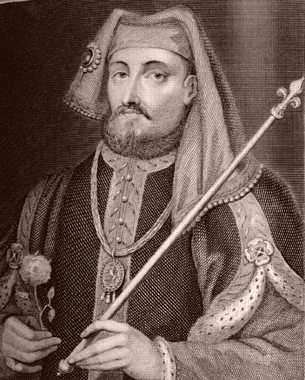Henry IV (2)
Within a year of Henry's gaining the throne, a conspiracy to restore Richard II made it necessary for Henry to eliminate him*.
Soon after Richard's death, Edmund Mortimer* joined with the disaffected Percys and the Welsh leader Owain Glyndwr (Glendower). The Percys* now claimed to have had no intention of deposing Richard and with their allies planned to divide the kingdom into three parts, giving the crown to its rightful heir, Edmund's young nephew, fifth Earl of March--confusingly also named Edmund Mortimer. (Click here to read more about the proposed division*.) This rebellion was crushed at Shrewsbury in 1403, before the Percys could meet with Glyndwr's army.
Footnotes
-
Richard's murder
Shakespeare mitigates Henry's complicity in the regicide by having Exton interpret his desire for Richard's death from a reported conversation, rather than requesting it outright. (See Richard II, 5.4.1-11.)
-
Edmund Mortimer
An uncle of the legitimate heir general to the throne, Edmund Mortimer was captured by Glendower in 1402. The King's refusal to pay Mortimer's ransom was a factor inciting Hotspur to rebellion, since he was married to Mortimer's sister Elizabeth. Mortimer joined forces with Glendower, continuing to fight with him even after the defeat of the Percys at Shrewsbury (1403).
-
The Percy brothers
These were the two Henrys, the Earl of Northumberland and his son (Hotspur), together with the elder's brother Thomas Percy, Earl of Worcester.
Contrary to Shakespeare's portrayal of him, Hotspur was about 37 years old at the Battle of Shrewsbury rather than a peer of the 16 year old Prince of Wales.
-
The kingdom divided
The three rebels, Percy, Mortimer, and Glyndwr, planned to divide the kingdom into three parts, with Mortimer the nominal king. The map shows the three divisions: in Henry IV, Part One, Shakespeare illustrates the tensions between the rebels by having them argue about a bend in the River Trent on the border between two parts:
Hotspur: See how this river comes me cranking in
And cuts me from the best of all my land,
A huge half-moon, a monstrous cantle [chunk] out.
I'll have the current in this place dammed up,
And here the smug and silver Trent shall run
In a new channel, fair and evenly.
It shall not wind with such a deep indent. . .
Glendower: Not wind? It shall, it must! You
see it doth.
(3.1.97-105)
